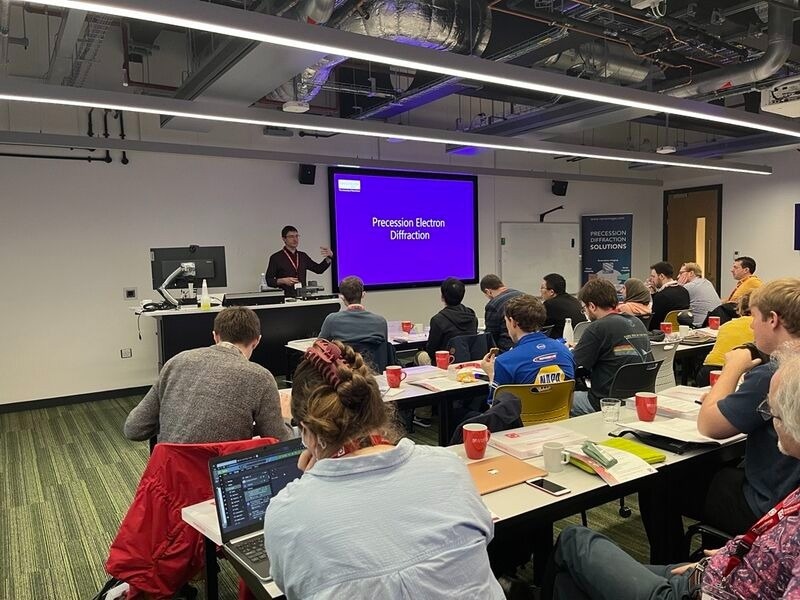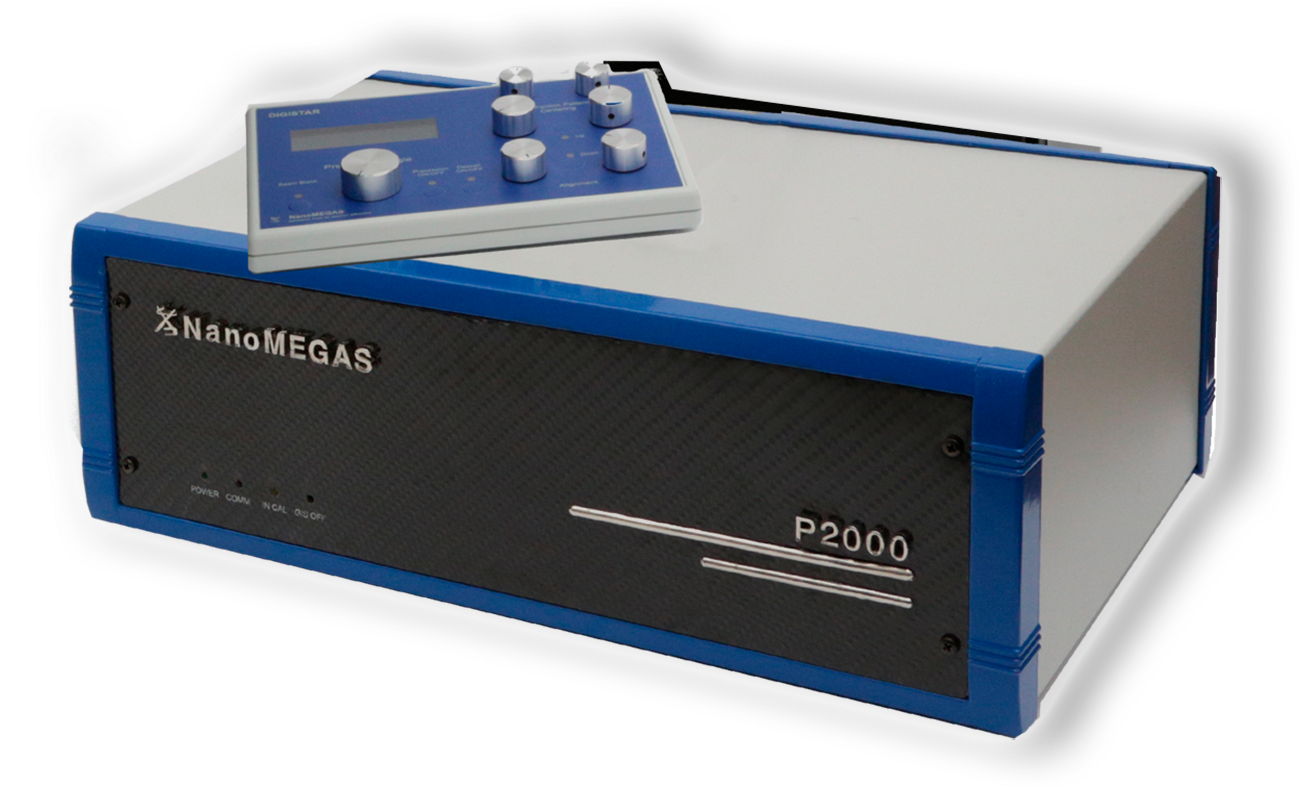Last November, Quantum Design and NanoMEGAS invited industry and research professionals to learn more about the theoretical and practical applications of Precession Electron Diffraction (PED). Fittingly hosted at The University of Manchester’s new home for Engineering and Materials research activities, AZoNano was given the opportunity to join the interactive workshop.

Dr. Alexander Eggeman leading his session. Image Credit: NanoMEGAS/QuantumDesign UK
Guided by expert-led discussions from NanoMEGAS, Jacobs and The University of Manchester itself, attendees were able to broaden their understanding of the benefits of Precession Electron Diffraction techniques for electron microscopy applications.
Accompanying these sessions were several live demonstrations throughout the afternoon, which allowed attendees to see precession data processing and analysis firsthand from locations across the world.
Bringing High-Tech Tools to Materials Research
For more than 30 years, Quantum Design UK and Ireland have worked with industry-leading laboratory instrument manufacturers to distribute high-tech equipment to industrial and academic research environments.
Established in 2004 by researchers active in electron diffraction, NanoMEGAS is a company that aims to provide advanced electron diffraction techniques for TEM microscopy. Speaking on their history with electron diffraction techniques, Dr. Nicolopoulos Stavros, Director and Founder of NanoMEGAS SPRL, explains how the company was the “first to develop and commercialise Precession Electron Diffraction (PED) products to expand TEM analytical potential using 4D-STEM applications.”
These applications range from Phase and Orientation Mapping (ASTAR) down to one-nanometer scale to 3D Diffraction Tomography of nanometer-sized crystals to determine their structure. In fact, NanoMEGAS found that by 2004, over 900 publications involving electron beam precession and use in structure analysis utilized this approach to confirm the structure of crystals, with several from materials previously unsolvable using traditional crystallography methods.
NanoMEGAS notes that this technique would also benefit activities investigating amorphous materials using Electron pair Distribution Function (e-PDF).
In 2013, NanoMEGAS began its partnership with Quantum Design to access markets across UK and Ireland.
QD has proven to be very competent, reliable, pro-active and well connected to scientific community. We have developed a good working relationship and look forward to growing with them in the future.
Dr. Nicolopoulos Stavros, Director and Founder NanoMEGAS SPRL, Brussels
Already, over 240 laboratories worldwide have installed and continue to use NanoMEGAS precession systems1. As such, it is no surprise that NanoMEGAS was best suited to host this workshop.
The Workshop
NanoMEGAS’ own Application Specialist Thanos Galanis kicked off the session by giving a general introduction to the event and walking through the primary applications of precession. Phase orientation mapping, strain mapping, PED tomography and e-PDF, were some of those highlighted.
Continuing the conversation, Dr. Alexander Eggeman, an electron microscopist based at The University of Manchester, began the next session.
Dr. Eggeman’s activities are centered around the use of electron diffraction approaches to investigate the atomic structure of complex nanomaterials. He has notable expertise in traditional and precession electron diffraction in various modes, as well as simulating diffraction data via computer-based methods.
Speaking to Dr. Eggeman at the event, AZoNano was able to gain an appreciation for the role both this technique and equipment from NanoMEGAS have played over the course of his academic career.
We knew right away that we wanted to work with Alex Eggeman at the Department of Materials at the University of Manchester to put on this workshop. The venue is great and we really enjoyed his talk on the theory and practical aspects of PED and its applications, with the interactive data.
Dr. Shayz Ikram, Technical Director, Quantum Design UK and Ireland
As explained by Dr. Eggeman, when using transmission electron microscopy (TEM), precession electron diffraction (PED) enables the operator to obtain electron diffraction patterns, where the incident electron beam is tilted and rotated (precessed) around the microscope’s central axis. Integration over several diffractions conditions allows the formation of a PED “quasi-kinematical” pattern that is well-suited for determining crystal structures via direct methods.
Applications of PED range from strain mapping at the nanoscale to microstructure of materials for solar cell technologies; one session of this workshop showcased emerging results of how this method can be used in industrial corrosion applications.
Samuel Armson, a Corrosion Scientist at Jacobs, returned to The University of Manchester – where he had previously achieved his Ph.D. – to lead this talk, building on Dr. Eggeman’s previous session. Here, Armson demonstrated how by utilizing ASTAR, EBSD, and TKD, the mechanistic understanding of nuclear fuel cladding corrosion could be improved.

Image Credit: NanoMEGAS/QuantumDesign UK
Bringing Together Professionals Across Industry and Research
Throughout each session, AZoNano saw firsthand the active conversations taking place among attendees and with the hosts themselves around Electron Diffraction and the potential of NanoMEGAS solutions. It was clear that while NanoMEGAS and QuantumDesign provided an environment for individuals to learn more about the benefits of this advanced technique, through these conversations, they also facilitated the chance for collaborations and innovations across the field.
Commenting on his experience of the event, attendee Dr. Ian MacLaren said, "It was excellent to have the chance to connect with other users and potential users of the Nanomegas ASTAR/TopSpin scanning precession electron diffraction system. We are particularly interested in automated crystal orientation mapping, strain mapping, and electron crystallography."
It was really good to see how others are using the Nanomegas systems and to see new systems being delivered via Quantum Design UK and Ireland.
Dr. Ian MacLaren, Reader (Physics and Astronomy), Glasgow University
To learn more about NanoMEGAS or QuantumDesign UK and their events, visit NanoMEGAS and QuantumDesign UK.
References
NanoMEGAS (2023) PRECESSION ELECTRON DIFFRACTION AND APPLICATIONS [online] Available at: https://nanomegas.com/precession-electron-diffractionand-applications/